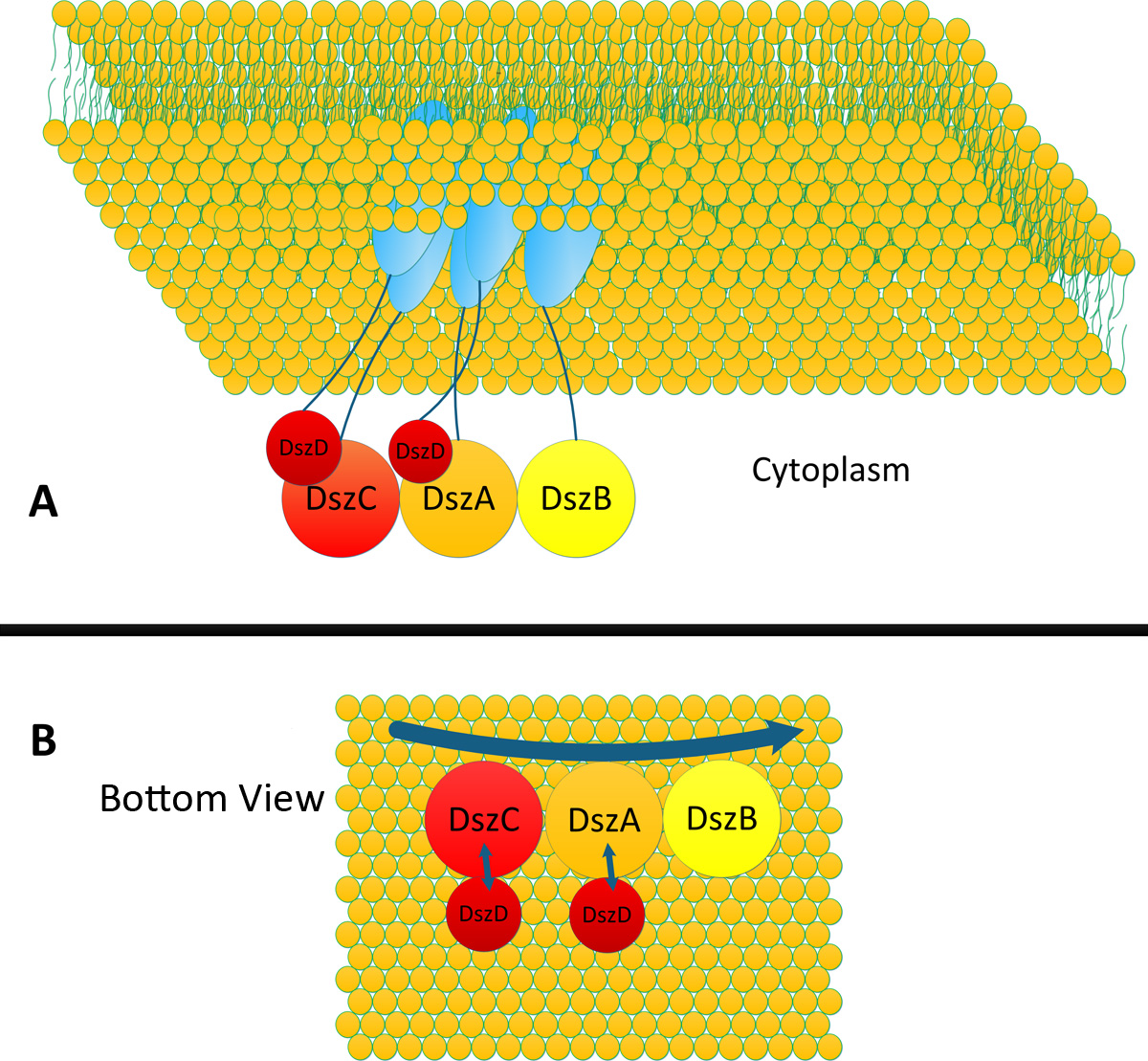Membrane Accelerator
- PAH Degradation & DBT Desulfurization
Natural biodegradation is a very slow process but indispensible in environment restoration. Previous synthetic scaffold system has been used to accelerate biosynthetic pathway. We are trying for the first time to recruit scaffold system to accelerate biodegradation pathway. It offered a new direction in the application of synthetic scaffold system.
To testify the feasibility of Membrane Accelerator in Biodegradation Pathway
To accelerate degradation of Polycyclic Aromatic Hydrocarbon (PAH)
To accelerate desulfurization of Dibenzothiophene (DBT)
To show the superiority of membrane scaffold in organizing enzymes into two dimensional pattern
a brand-new concept proposed to apply scaffold system in facilitating biodegradation pathway
2 well-studied biodegradation pathways selected, which could potentially benefit environment restoration
Biodegradation of Polycyclic Aromatic Hydrocarbon (PAH)
Background
Polycyclic aromatic hydrocarbons (PAHs), which consist of two or more fused aromatic rings, are widespread in the environment and persist for a very long time. Some PAHs are toxic, mutagenic and carcinogenic and therefore are health hazards. Efforts have been made to screen bacteria strains that could degrade PAH. Moreover, many researchers focused on studying the mechanism of PAH biodegradation. But the rate of natural biodegradation is relatively slow. We are trying to build a Membrane Accelerator to speed up proceeding rate of PAH biodegradation process. Naphthalene degradation pathway in Pseudomonas species is well studied and thus recruited in our project to build PAH-degrading Membrane Accelerator. This is the very first time that scaffold system has been applied in accelerating Biodegradation pathway.
Degradation Pathway
We recruited naphthalene degradation pathway in Pseudomonas species, which has been well characterized. Six crucial enzymes are involved in naphthalene degradation pathway.
 Fig1: Demonstration of naphthalene degradation pathway in Pseudomonas species In the first catabolic step, an oxygen molecule is introduced at the 1,2-position of the aromatic nucleus to produce cis-1,2-dihydroxy-1,2-dihydronaphthalene by naphthalene dihydrodiol dioxygenase(NahA). cis-1,2-Dihydroxy-1,2-dihydronaphthalene is then dehydrogenated to 1,2-dihydroxynaphthalene by cis-naphthalene dihydrodiol dehydrogenase(NahB). 1,2-Dihydroxynaphthalene is cleaved by 1,2-dihydroxynaphthalene dioxygenase(NahC), and the resulting ring-cleavage product spontaneously cyclizes to form 2-hydroxy-2H-chromene-2-carboxylic acid. Enzymatic reactions by an isomerase(NahD) and a hydratase-aldolase(NahE) result in the production of salicylaldehyde, which is then transformed to salicylate by salicyladehyde dehydrogenase(NahF).
Design of Experiment
To test whether Membrane Accelerator could accelerate naphthalene biodegradation pathway, we are trying to link six crucial enzymes (NahA, B, C, D and E) to orderly organized membrane anchors and expressed them in E.coli. E.coli expressing the same type and amount of cytoplasmic enzymes is set as control group.
 Fig2: Demonstration of Membrane Accelerator designed for speeding naphthalene biodegradation process Biodesulfurization of Dibenzothiophene (DBT)
Background
We found that many iGEM teams wanted to express enzymes of biodegradation pathway in E.coli. However, it doesn't have significant superiority compared to traditional strain screening strategy. The power of synthetic biology is not fully demonstrated here.
We got inspired by project of 2012 iGEM team Calgary. One of their goals is to achieve desulfuration of dibenzothiophene in E.coli. Sulfur in crude oil could contribute to global warming, acid rain, and various health issues.
Biodesulfurization of fossil fuel could help upgrade the quality of fossil fuel and thus the whole environment. To upgrade this system, we aimed to link related enzymes to orderly organized membrane anchors, which would accelerate desulfurization pathway remarkably.
Desulfurization Pathway
Four enzymes are involved in the 4S desulfurization pathway. Dibenzothiophene monooxygenase (DszC) is responsible for converting DBT to DBT-sulfoxide and finally to DBT-sulfone (DBTO2). DBT-sulfone monooxygenase (DszA) then carries out the next step in the pathway, producing 2-hydroxybiphenyl-2-sulfinic acid (HBPS). HBPS is then converted to the final product by HBPS desulfinase (DszB), producing 2-HBP. The sulfur is released from the hydrocarbon in the form of sulfite.
Note that the first three steps of the this Desulfurization pathway require FMNH2 as a reductant. In order to regain this power an Oxidoreductase (DszD) uses NADH to recycle the FMNH2, allowing the reaction to proceed. For more information, click Wiki of team Calgary
 Fig3: The 4S Desulfurization Pathway, showing the desulfurization of the model compound DBT by DszA, DszB, DszC, and DszD. Design of Experiment
As shown above, DszD plays a special role in this Biodesulfurization pathway: offering FMNH2 for DszC and DszA. Ideal organization of the four enzymes should be DszC, DszA and DszB aligning together, with DszD paired with DszC and DszA respectively(Fig.4). In this way, metabolic flux in desulfurization pathway could be facilitated and accelerated. All intermediates could be passed to downstream enzymes efficiently. Furthermore, paired DszD could offer sufficient amount of FMNH2 for DszC and DszA in time.
 Fig4: Ideal organization of DszA, DszB, DszC and DszD in desulfurization pathway. In each assembly two DszD should be paired with DszC and DszA respectively to offer FMNH 2 timely This ideal organization of enzymes is hard to achieve with traditional linear synthetic scaffolds. However, Membrane Scaffold is two dimensional, so we can organize corresponding enzymes in desired two dimensional pattern. This again shows the superiority of Membrane Scaffold.
We are trying to organize DszA, DszB, DszC and DszD according to the pattern shown in Fig4. Due to decreased distance between those enzymes and optimized organization, the proceeding speed of Biodesulfurization pathway should increase sharply.
 Fig5: Sketch map of Desulfurizing Membrane Accelerator. Fig5A shows the three dimensional sketch of the device; Fig5B offers a bottom view of the device. Reference
1.Habe, H. and T. Omori (2003). "Genetics of polycyclic aromatic hydrocarbon metabolism in diverse aerobic bacteria." Bioscience, biotechnology, and biochemistry 67(2): 225-243.
2.Soleimani, M., A. Bassi, et al. (2007). "Biodesulfurization of refractory organic sulfur compounds in fossil fuels." Biotechnology advances 25(6): 570-596.
|